What is Infrastructure?
Infrastructure refers to the basic facilities and structures that help a country function smoothly. This includes:
- Transportation: Roads, railways, airports, and ports
- Energy: Power plants, electricity grids
- Water Supply and Sanitation: Pipes, sewage systems, water treatment plants
- Communication: Internet, phone lines, and communication towers
- Housing and Urban Development: Buildings, public spaces, and housing projects

Basically, infrastructure is everything that allows a country to operate and grow.
What is India’s Infrastructure Development?
India’s infrastructure development means the process of building and improving these essential systems and facilities to support the country’s growth. Over the past few years, India has been focusing on expanding and improving its infrastructure to support its growing population and economy.
India is working on improving transportation, energy, communication, and housing, among other things. Let’s look at some key areas of infrastructure development in India:
1. Transportation Infrastructure
Roads and Highways:
- India has a large network of roads, but the government is working to improve them by building expressways, national highways, and rural roads. This will help make travel faster, reduce traffic, and connect remote areas to cities.
- Prime Minister’s Gati Shakti National Master Plan aims to improve logistics and reduce transportation costs by improving road connectivity.
Railways:
- India has one of the largest railway networks in the world. The government is modernizing the railways with new trains, faster routes, and better stations.
- Projects like Dedicated Freight Corridors are being built to help move goods faster and more efficiently.
Airports:
- India is expanding its airports and building new ones, especially in small towns. This helps improve domestic and international travel.
- New Greenfield airports (airports built from scratch) are being built to cater to the growing number of travelers.
Ports:
- India’s ports are being modernized and expanded to handle more cargo, supporting international trade.
- The government is also improving inland waterways, which is a more eco-friendly way to transport goods.
2. Energy Infrastructure
Power Generation:
- India is focusing on increasing its power generation capacity, including renewable energy sources like solar power and wind energy.
- Large-scale solar parks and wind farms are being set up to produce clean and sustainable energy.
Electricity Transmission:
- The electricity grid is being improved to ensure that power can be efficiently distributed across the country, especially in rural areas.
- Smart grids are being introduced to make the distribution of electricity more efficient and reliable.
Electric Vehicles (EVs):
- To reduce pollution and dependency on fossil fuels, the government is promoting electric vehicles (EVs) and building charging infrastructure for them.
3. Water Supply and Sanitation
Water Supply:
- India is building new water supply systems and improving old ones to ensure clean drinking water reaches every home. Projects like the Jal Jeevan Mission aim to provide piped water to rural households.
Sanitation:
- The Swachh Bharat Abhiyan (Clean India Mission) has been a major initiative to improve sanitation in both rural and urban areas. It focuses on building toilets and improving waste management.
- The goal is to create a cleaner and healthier environment for citizens.
4. Communication and Technology Infrastructure
Broadband and 4G/5G:
- India is expanding its broadband network to provide high-speed internet to more people, especially in rural areas. This is crucial for education, business, and healthcare.
- The rollout of 5G networks will improve mobile internet speed and open new possibilities for industries like healthcare, education, and manufacturing.
Smart Cities:
- The government is working on the Smart Cities Mission, which aims to use technology to make cities more efficient and livable. This includes better traffic management, energy-efficient buildings, and improved public services.
5. Housing and Urban Development
Affordable Housing:
- With India’s growing population, there is a high demand for affordable housing. The government is working on projects like Pradhan Mantri Awas Yojana (PMAY) to build affordable homes for people, especially in urban areas.
Urban Infrastructure:
- Metro rail systems are being built in many cities to reduce traffic congestion and provide better public transport options.
- There is also a focus on smart buildings, public parks, and green spaces to improve the quality of life in urban areas.
Challenges in Infrastructure Development
Despite all the progress, there are some challenges India faces in its infrastructure development:
- Funding: Building and maintaining infrastructure requires large amounts of money. The government often has to rely on both domestic and foreign investments.
- Land Acquisition: For big infrastructure projects like highways or factories, the government needs land. Acquiring land can sometimes be a difficult and time-consuming process.
- Environmental Concerns: As infrastructure grows, it’s important to balance development with environmental protection. Ensuring that projects are eco-friendly and sustainable is a challenge.
- Urbanization Pressure: As more people move to cities for jobs, there is pressure to build infrastructure quickly, which can sometimes lead to overcrowding and strain on resources.
Opportunities for Growth
- Green Infrastructure: There is a growing focus on building eco-friendly infrastructure, like solar-powered buildings, sustainable cities, and green transportation options. This will help protect the environment while promoting development.
- Public-Private Partnerships (PPP): By partnering with private companies, the government can speed up infrastructure projects, improve quality, and share the financial burden.
- Technology Integration: Using smart technologies can improve the efficiency of public services and transportation systems, making life easier for citizens.
Conclusion
India is rapidly developing its infrastructure in areas like transportation, energy, water supply, communication, and housing. While there are challenges such as funding, land acquisition, and environmental concerns, there are also many opportunities for growth through sustainable and tech-driven solutions.Improving infrastructure will help India grow economically, provide better services to its citizens, and improve the quality of life for everyone, especially as the country continues to urbanize and develop.











